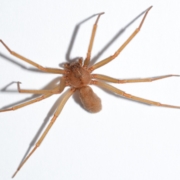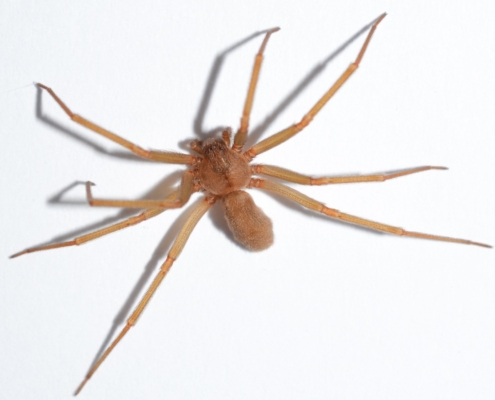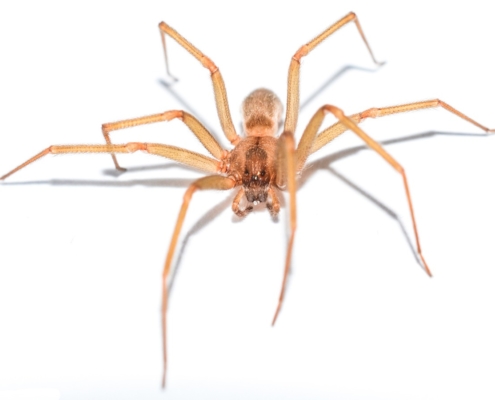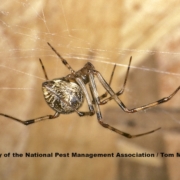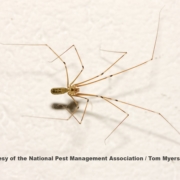Types of Spiders
Jumping Spiders (Salticidae)
Black widow spiders are most recognized for the red hourglass shape under their abdomen. This spider gets its name from the popular belief that the female black widow spider eats the male after mating, although this rarely happens. Black widows are poisonous when ingested during the first 17 days of their life.
Elite Pest Management, LLC-Bed Bug and Termite Services
Color
Usually black, sometimes brown, tan, or gray, and usually with pale markings.
| Legs | 8 |
|---|---|
| Antennae | No |
| Region | Found throughout U.S. |
Shape
Compact with relatively short legs
Size
1/8 – 3/4 inches
Habits
Black widows are active when the temperature is 70 degrees or higher, but they can survive lower temperatures with the right conditions. Black widow spiders spin irregular webs, which they build at night near ground level. Once complete, these spiders hang upside-down in their webs.
Habitat
Outdoors, black widow spiders commonly live in protected areas like under stones and in firewood piles. They are often found in barns, outhouses and sheds. Indoors, black widows prefer cluttered areas of garages, basements and crawl spaces.
Threats
While male black widow spiders rarely bite, females are known to be aggressive and bite in defense, especially after laying, and when guarding eggs. Symptoms of a black widow spider bite include fever, increased blood pressure, sweating and nausea. Fatalities are unlikely, as long as proper medical treatment is sought in a timely manner. If you notice black widows or signs of infestation, contact a professional immediately for a proper course of black widow spider control.
Black Widow Spider Prevention
Avoid black widow spider bites by reducing clutter in basements and garages to eliminate hiding spots. When spider webs are visible, use caution before putting your hands or feet in that area. You should also wear heavy gloves when moving items that have been stored for a long period of time and shake out shoes before wearing them. Outdoors, store firewood at least twenty feet from the home and five inches off the ground. If you suspect a spider infestation, contact a black widow control specialist immediately. This is the safest way to get rid of black widow spiders in the home.
Brown Recluse Spiders (Loxosceles reclusa)
Brown recluse spiders have a characteristic dark brown violin marking on their back. These spiders often infest cedar shake roofs and spin irregular webs, which are used as a retreat.
Elite Pest Management, LLC-Bed Bug and Termite Services
Color
Usually black, sometimes brown, tan, or gray, and usually with pale markings.
| Legs | 8 |
|---|---|
| Antennae | No |
| Region | Found in the south central Midwest from Ohio to Nebraska and south through Texas to Georgia. |
Shape
Round
Size
1/4 – 1/2 inch long
Habits
Brown recluse spiders are nocturnal and eat other small bugs like cockroaches and crickets. These spiders spin irregular webs, which are not used for catching prey but rather as a retreat.
Habitat
Brown recluse spiders often live outdoors where they are typically found around rocks, utility boxes and woodpiles. Indoors, brown recluses can be found in any undisturbed area, such as inside boxes, among papers, in seldom-used apparel and shoes, under furniture or in crevices of window moldings. Closets, attics, crawl spaces and basements are the most common brown recluse spider hiding spots.
Threats
Like the black widow spider, the brown recluse spider bites in defense and does not bite humans instinctively. However, both female and male brown recluse spiders can bite and inject venom. The brown recluse’s bite is usually not felt, but results in a stinging sensation followed by intense pain as long as six to eight hours later. A small blister usually develops at the bite location that can turn into an open ulcer. Restlessness, fever and difficulty sleeping are common symptoms of a brown recluse spider bite.
Brown Recluse Spider Prevention
To avoid brown recluse spiders, do not leaving clothing on the floor. Store clothing and shoes inside plastic containers, and shake out all clothing that has been in a hamper before wearing or washing. To get rid of brown recluse spiders, contact a pest professional with brown recluse spider control experience.
Hobo Spiders (Tegenaria Agrestis (Walckenaer)
The common name for the hobo spider comes from its presumed method of expanding its distribution by hitching rides with humans along major highways in the Pacific Northwest. In fact, the hobo spider was introduced from Europe in the 1930s and has become established in at least 6 states since, displacing many native spider species as it spreads.
Elite Pest Management, LLC-Bed Bug and Termite Services
Color
Light to medium brown with dark stripe down center to either side of lighter midline stripes; legs solid light brown with no bands
| Legs | 8 |
|---|---|
| Antennae | No |
| Region | Common in the northwestern U.S.; appears to be expanding its range |
Shape
Oblong abdomen with longer posterior spinnerets visible from above
Size
1 – 1 and 3/4” (40-50 mm) in diameter, including legs. Body sizes range from 5/16” to 9/16” with females slightly larger than males
Habits
Hobo spiders build funnel webs that open at both ends with one end expanding outward into a broad, slightly curved sheet. An escape tunnel is commonly built in the back of the web which leads to a deep crack or other protected area. From late June to October, males extensively wander about seeking a mate. Several roving males may in fact enter the ground level of a structure each day during the peak activity period in August and September. Male hobo spiders are responsible for more bites than female hobo spiders because this wandering habit brings them into contact with humans.
Habitat
Hobo spiders may be found in almost any habitat containing holes, cracks or crevices which can support tunnel formation. Since they are poor climbers, they are rarely found above ground level. They frequent dark, moist areas and are most often found in basements, window wells and crawl spaces.
Threats
The hobo spider will bite in defense; however there is debate around the effects of hobo spider bites as these spiders are frequently confused with other species. In fact, misinformation on hobo spiders is so prevalent that it was previously thought that they are capable of producing a necrotic lesion similar to that caused by brown recluse spiders. However, much of the evidence in such cases has been circumstantial. The prevailing thought is that hobo spider bites causes only mild pain and redness.
If you notice hobo spiders, contact a professional immediately to discuss how to get rid of the infestation through a proper course of pest control.
Hobo Spider Prevention
To avoid hobo spiders, seal cracks on the outside of the home, and screen all doors and windows. Reduce clutter in basements and garages to eliminate hiding spots and keep these areas dry. Avoid storing clothing or shoes on the floor and use caution when moving items that have been stored for a long period of time. To get rid of hobo spiders, contact a pest professional.
Common House Spiders (Achaearanea tepidariorum)
The common house spider is usually the spider most often encountered indoors. It is a nuisance pest, probably more because of its webs than the spider itself. The house spider is found worldwide and is common throughout the United States and Canada.
Elite Pest Management, LLC-Bed Bug and Termite Services
Color
Yellowish brown, abdomen dirty white with several dark stripes meeting at angle
| Legs | 8 |
|---|---|
| Antennae | No |
| Region | Found throughout the U.S. |
Shape
Elongated Abdomen
Size
3/16 – 5/16“ (female) 1/8 – 3/16” (male)
Habits
The house spider randomly selects its web locations and creates a tangled web. If a web does not yield prey it is abandoned, another site is selected, and a new web is built.
Habitat
House spiders have a difficult time surviving in modern homes due to low humidity and fewer insects for food. They are more likely to prosper inside structures like garages, sheds, barns and warehouses. Outside, these domestic spiders are often around windows and under eaves, especially near light sources that attract prey.
Threats
Common house spiders are nuisance pests, but they pose no threats to humans.
Common House Spider Prevention
To prevent common house spiders from entering the home, seal cracks and use screens on windows and doors. Use a vacuum to remove adults, egg sacs and webs. If a broom is used, adult house spiders can usually escape.
Jumping Spiders (Salticidae)
About 300 species of jumping spiders are found in the United States and Canada. Unlike most spiders, jumping spiders are active during the daytime and seem to like sunshine.
Elite Pest Management, LLC-Bed Bug and Termite Services
Color
Usually black, sometimes brown, tan, or gray, and usually with pale markings.
| Legs | 8 |
|---|---|
| Antennae | No |
| Region | Found throughout the U.S. |
Shape
Compact with relatively short legs
Size
1/8 – 3/4 inches
Habits
Jumping spiders do not construct snare webs but do build web retreats which are loosely woven, saclike, composed of several envelopes and usually have two openings. Unlike most spiders, jumping spiders are active during the daytime and seem to like sunshine. They are hunters and have the keenest vision of all spiders, being able to detect and react to movement up to 18″ in distance; however their night vision is very poor. They can rapidly move both sideways and backwards for short distances. As their name implies, they are excellent jumpers.
Habitat
Retreats may be built under furniture, in drapery folds, between books on bookshelves, in cracks found in wood floors, around door and window molding, etc. Outside retreats may be found under loose bark, between leaves, etc. Indoors, spiders will usually be found hunting around windows and doors because more insects are attracted to these areas and their vision is best in sunlit areas. Outdoors, jumping spiders are commonly seen running over tree bark, under stones and boards, on bushes, fences, decks and the outside of buildings, especially sunny areas.
Threats
While they can bite, the jumping spider bite is not poisonous. They are not considered dangerous.
Common House Spider Prevention
Need to know how to get rid of jumping spiders? In addition to sealing cracks and screening doors and windows, exclusion and the removal of outdoor harborages is key. Indoors, removal with a vacuum is best followed by disposal of the vacuum bag outside.
Long-bodied Cellar Spiders (Pholcus phalangioides)
Long-bodied cellar spiders are commonly referred to as “daddy-long-legs” because of their very long, thin legs, and as their name implies, are found in dark and damp places like cellars and basements. There are about 20 species of cellar spiders in the United States and Canada.
Elite Pest Management, LLC-Bed Bug and Termite Services
Color
Pale yellow to light brown or gray
| Legs | 8 |
|---|---|
| Antennae | No |
| Region | Found throughout the U.S. |
Shape
Long skinny legs with a small body
Size
¼-3/8” (6-9mm)
Habits
Cellar spiders seem to fare better in areas with higher relative humidity. These spiders build loose, irregular, tangled webs in corners, and hang upside down on the underside of them. The webs are not cleaned but rather new webs are continually added. This habit can result in extensive webbing in a relatively short time. When disturbed on its web, the cellar spider has the habit of rapidly shaking its body in a rotary movement to confuse and entangle the prey.
Habitat
Long-bodies cellar spiders and their webs are usually found in dark and damp places, such as cellars, basements, and crawl spaces. They can also be found in the corners of garages, sheds, barns and warehouses, on eaves, windows and ceilings, and in closets, sink cabinets and bath-traps.
Threats
Cellar spiders do not pose a threat to humans, as their weak mouthparts keep them from injecting venom into humans.
Long-Bodied Cellar Spiders Prevention
To keep long-bodied cellar spiders out, seal cracks on the outside of the home, especially around doors and windows, and use screens to prevent entry into homes. Using yellow light bulbs for exterior lighting may reduce the number of cellar spiders and other insects, as they are typically attracted to white-light sources. Additionally, lowering the humidity in basements, cellars and crawl spaces with the use of a dehumidifier or ventilation can discourage cellar spiders from living there.
Wolf Spiders (Lycosa)
Unlike most spiders, wolf spiders don’t hunt with webs. Instead, they chase their prey using their fast running ability. These spiders are often big and hairy which alarms some people, but they are primarily nuisance pests. Over 100 species of wolf spiders are found in the United States and Canada.
Elite Pest Management, LLC-Bed Bug and Termite Services
Color
Usually dark brown, often with paler (or sometimes yellow) stripes or markings
| Legs | 8 |
|---|---|
| Antennae | No |
| Region | Found throughout the U.S. |
Shape
Stout-robust body with long, spiny legs
Size
3/8 – 1 3/8“ (female) 1/4 – 3/4“ (male)
Habits
Wolf spiders actively hunt during the night and usually rest in sheltered places during the day. They are fast on their feet and pursue prey. Because of these habits, wolf spiders are commonly seen by people.
Habitat
Wolf spiders may enter structures in search of prey. Although they are not inclined to be permanent residents in structures, they often stay once inside. Indoors, wolf spiders tend to remain at or near floor level, especially along walls and under furniture. Outside, wolf spiders can be found under stones, landscape timbers, firewood, leaves and other debris.
Threats
Because wolf spiders feed on a variety of insects, including crop pests, they can be beneficial. Wolf spiders can bite, but it’s extremely rare to experience a wolf spider bite unprovoked. They will only bite if they are handled. The presence of wolf spiders in homes is usually accidental.
Wolf Spider Prevention
To get rid of wolf spiders, seal cracks on the outside of the home and use screens on doors and windows. Pest management professionals will often place glue traps where the wolf spiders have been seen in order to remove them from the home.









